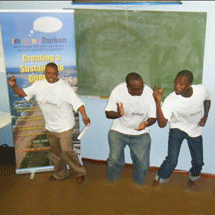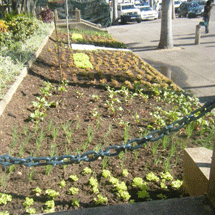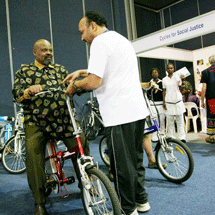[6 October 2010] -- A unique city planning initiative in Durban, South Africa is inspiring and mobilising residents and businesses alike to participate in the long-term planning process and create a shared vision for the future of the city.
The Imagine Durban initiative is a council-led project on integrated, long-term planning undertaken by eThekwini Municipality, which oversees Durban.
Its unique, participatory approach has attracted international attention – including a nomination for the prestigious Reinhard Mohn prize for 2011 – and offers valuable lessons for other cities that are involved in long-term planning.

Reaching out to youth was a central part of the Imagine Durban initiative. Photo: Imagine Durban
Through a creative use of communications and outreach efforts, Imagine Durban is mobilising all elements of the city – residents, businesses, government, civil society, and youth – to take part in creating a long-term vision for their city, many for the first time. The initiative also promotes long-term sustainability and a new approach to local government.
The result is an Action Plan for Durban’s future that is built on widespread community and stakeholder engagement as well as on gender equity. The city’s various sectors are implementing and operationalising the plan, with the Municipality serving as a partner that contributes expertise as well as funding.
The initiative is being implemented in conjunction with Sustainable Cities, a non-governmental organisation from Vancouver, Canada and the PLUS Network (a network of 35 cities sharing experiences in sustainability planning) who have received funding from the Canadian International Development Agency to support the project.
Envisioning a new role for local government
The largest city on the east coast of Africa and South Africa’s busiest port, Durban has a population of around 3.5 million. It is part of the eThekwini Municipal Area, which was formed in 1996 and is overseen by the eThekwini Municipality.

Imagine urban used creative approaches, such as a road show for municipal officials, to gain support for the initiative. Photo: Imagine Durban.
As South Africa moved from an apartheid state to a democratic society following the country’s first-ever democratic elections in 1994, eThekwini Municipality struggled to overcome a legacy of apartheid and racial exclusion that had created poverty gaps, wealth disparities and inequality between racial groups.
In spite of increased spending in black African neighborhoods, satisfaction with government services among the city’s black African residents declined.
Concerned, local political leaders decided that the city’s planning needed to be participatory and more outcome-focused. They envisioned a new role for local government; instead of being a provider of services to passive recipients, eThekwini Municipality would be a facilitator of social action. In that spirit, the Imagine Durban project was conceived.

A vegetable garden at Durban City Hall. Photo: Imagine Durban
Imagining a future for Durban
In order to begin the process, the Imagine Durban team distributed postcards in restaurants, libraries, regional centres, and schools throughout the city asking residents what they liked or disliked about their communities.
They targeted all residents of the city from all walks of life, making a special effort to reach out to youth, women, the elderly and the disabled.
Based on their answers, six themes were identified as the most important to citizens for collective action:
-- Creating a safer city
-- Ensuring a more environmentally sustainable city
-- Promoting an accessible city
-- Creating a city where all enjoy sustainable livelihoods
-- Fostering a more caring and empowering city
-- Celebrating the city’s cultural diversity, history and heritage
The Imagine Durban project then held workshops, invited citizens to post on its blog, and hosted competitions on the best solutions to the city’s problems. Based on all the creative ideas that emerged, the Municipality drafted the Imagine Durban Plan: a strategy for action that serves as a guiding document for the Municipality.
For each of the six themes outlined above, the Plan articulates a goal. Each goal has a set of short, medium and long-term targets to provide measurable indicators of success. The plan also includes a set of actions that can be taken by each of the stakeholder groups – individuals, civil society, businesses, local government, and provincial and national government – to achieve that goal.
Now that the Imagine Durban Action Plan is complete, the city is moving onto the implementation phase of the project, dubbed “Create Durban”. During this phase, the Municipality will organise and mobilise other areas of government, business, civil society and individuals to begin implementing projects and programmes related to the Action Plan.
Making a difference, collectively
Two years into the planning process, the Imagine Durban project has had a considerable impact on the city as a whole. It has changed the approach to government in Durban; instead of viewing itself as a provider of services that looks narrowly at its spending programmes, the Municipality sees itself as a facilitator of actions by others.
The project has also inspired residents and civil society in Durban to undertake projects or actions that contribute to achieving the Imagine Durban goals.

The Mayor of eThekwini Municipality, Obed Mlaba, attending the Sustainable City Exhibition in Durban. Photo: Imagine Durban
For example, some residents and schools have begun implementing activities to promote the goal of ensuring a more environmentally sustainable city, such as energy efficiency, waste minimisation, vegetable gardens and the harvesting of rain water.
Some of these initiatives that are contributing to Imagine Durban’s focus on sustainability were highlighted at the Sustainable City Exhibition, hosted by eThekwini Municipality as part of the Imagine Durban project in August 2010. The exhibition, the first of its kind in the city, showcased unique creations, efforts, services and products that aim to inspire green living.
Thirty-two examples of these local sustainability efforts were documented in the publication Innovations in Local Sustainability – Good Practice from eThekwini, which was prepared by eThekwini Municipal Institute of Learning and Imagine Durban.
For More Information
The Imagine Durban Action Plan
Download The Power of Imagination: Long-Term Planning for City Sustainability
Read a CIVIS Note on Thinking Globally, Acting Locally: Institutionalising Climate Change within Durban’s Local Government
|
Lessons for long-term planning In their publication The Power of Imagination: Long-Term Planning for City Sustainability, the Imagine Durban team shares the ten most important general lessons that they learned during the first two years of the planning process: -- Partner with an NGO. Because Imagine Durban was a partnership with a non-profit organisation (in this case, the International Centre for Sustainable Cities), and not an exclusively municipally-driven project, the initiative had the necessary legitimacy and credibility to enjoy the prolonged support of a diverse group of stakeholders. -- Take short-term actions to ensure long-term success. Initial focus groups of city residents rejected the idea of long-term planning, arguing that their immediate needs were more important. A series of 11 small-scale Demonstration Projects were implemented across the metropolitan area, and with the success of these projects, residents were more willing to accept the idea of long-term planning. -- Make sure the process is fully supported, especially by political leadership. The Imagine Durban team set up a range of structures to ensure that all sectors owned the process, including establishing public Theme Group meetings and a Steering Committee that represented all segments in the city. -- Mobilise schoolchildren. The team visited all the primary and secondary schools in the metropolitan area and gave children an opportunity to share their vision for the city. Not only did the children add creativity and enthusiasm to the process, but a whole new generation of citizens has learned to become involved in the city planning process. -- Experiment with new ideas. The Imagine Durban project benefited from exploring new, creative approaches, such as partnering with the Education Department to work in schools and local restaurants who enticed patrons to participate in the survey. Finding a balance between innovation and adherence to municipal procedures is key. -- Evaluate the process along the way. Build the need to reflect and evaluate into the methodology. It is less dispiriting to evaluate the process along the way than it is to realise at the end of the project that things have gone in the wrong direction. -- Follow through. By doing what they said they were going to do, the Imagine Durban team built credibility – especially important in post-apartheid context, where many communities doubted the government’s commitment to listen and deliver. This included actions such as sending out meeting minutes on time and responding to e-mails quickly. -- Communicate. Because behaviour change was one of the project’s key goals, a range of effective communications tools was essential. The team’s strategy included hiring a dedicated communications officer, contracting professional journalists to write key communication pieces, using different media and tools, tailoring presentations to different audiences, and ensuring that reports were written in plain language. -- Look for synergies. By keeping their eyes open for grassroots initiatives that supported the Imagine Durban goals, the team created a productive network that resulted in useful action on the ground and an increased profile for the project. For example, inviting a school principal to one of the project’s team meetings inspired her to rebrand all her school sustainability initiatives under the Imagine Durban banner. It is also important to develop a clear policy on stakeholder engagement and support at the outset. -- Trust in the process. Planning practitioners should have faith in the process. On many occasions, the Imagine Durban team second-guessed itself and the process, trying to predict outcomes or worrying unduly about stakeholder responses. These fears were unfounded; stakeholders bought into the process because of the team’s commitment to making sure everyone was heard and because they felt the project was their own. |




